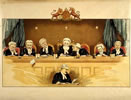Land grants
While Auckland offered assisted passages to domestic servants and builders, its main energies went into offering land to those who could pay their own way – 40 acres (16 hectares) per person aged 18 or over, and 20 acres for those aged 5 to 18. Agents were established in Britain and Ireland, and also in Canada and Cape Town. In the years the scheme was operating (1858–68) 14,516 land orders were issued, accounting for probably half of Auckland’s immigrants in those years. Among them were the first group of settlers from Staab in Bohemia (now part of the Czech Republic), who established a community at Pūhoi.
Waipū and Albertland
Two other significant group settlements were established in the Auckland region during this period.
From 1853 to 1860 some 800 people settled at Waipū in Northland. They were followers of a strict Calvinist preacher, Norman McLeod, who in 1820 had led people from the Highlands of Scotland to Cape Breton Island, in Nova Scotia. Suffering from poor crops and starvation, an initial group of migrants set off for Australia, but finding land expensive, they came on to New Zealand.
Another important religious group were the settlers of Albertland (named after Queen Victoria’s husband, Prince Albert). The community, on the Kaipara Harbour, was founded in 1862 to mark the bicentenary of the expulsion of the nonconformist clergy from the Church of England. Between 1862 and 1865, 3,000 people arrived in New Zealand under this scheme, although fewer than half made it to Albertland. Most were English nonconformist farm labourers.
Military settlers
As well as land, a second stimulus for organised migration in Auckland was the constant threat of military conflict with Māori. In 1864 and 1865 over 4,000 settlers arrived under the Waikato immigration scheme. A joint project of the Auckland and central governments, its aim was to place military settlers on land confiscated from Māori in the hope of consolidating territorial gains and increasing security. Largely a family migration, it attracted a considerable number of Protestant Irish, who settled around Pukekohe in particular.
Soldiers
In addition, two groups of soldiers were brought to Auckland province. In the midst of the Waikato war of the 1860s, the central government proposed the introduction of an armed population on conquered lands, to act as a buffer between colonists and Māori. In the event, four regiments of the Waikato militia were recruited (6,382 people in all), one to settle on land near Tauranga and Ōpōtiki, and the other three in the Waikato, around Cambridge and Hamilton. Many were recruited in Victoria, Australia. Four-fifths were male, and of these about a quarter were Irish.
Also, men discharged from regiments serving in the New Zealand wars were offered generous deals to purchase Crown lands. A total of 7,692 former soldiers acquired almost 350,000 acres (141,640 hectares) as a reward for their service. Most settled in the Auckland region, and once more well over half of them were Irish. Among the English, a considerable number came from the north.


